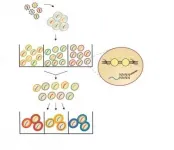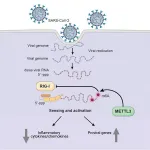Suppressing the impact of COVID-19 using controlled testing and isolation
Israeli researchers propose a technology-based method to streamline epidemiological research and coronavirus testing that can reduce the number of unnecessary tests and length of quarantine, reduce morbidity and mortality, and stop new waves of infection
2021-04-29
(Press-News.org) The outbreak of COVID-19 has revealed the widespread effects a pandemic can have on all spheres of life from health, to social life, to the economy. The main thrust of efforts to control the spread has been to decrease the reproduction rate to flatten the curve of the total number of infected individuals per day in order to reduce overload on the health system. The most widely implemented response to the exponential growth of the infection has been widespread quarantine and lockdown. While isolation is an effective tool to decelerate the spread, repeatedly imposing complete quarantine for a relatively long period of time until the virus is suppressed has negative effects on people's lives and on the economy. Moreover, if proper population monitoring is not enforced further waves of the disease may ensue. Therefore, early detection of positive test results is of paramount importance to suppress the spread of COVID-19 as soon as possible.
A second component in fighting the pandemic is to devise better testing policy. Today, health systems around the world prioritize the administration of tests to people who have had direct contact with an infected person or who are symptomatic. Some countries are implementing extensive resources to test people widely and randomly to detect areas where the pandemic is likely to spread. Nevertheless, these strategies do not use resources effectively.
A recent study, published in the journal Scientific Reports by Prof. Amir Leshem, from the Kofkin Faculty of Engineering at Bar-Ilan University, and Dr. Kobi Cohen, of Ben-Gurion University, offers a more effective method for the prioritization of tests using a feedback methodology. The key to the proposed method is to test individuals with a high probability of being infected and identify them before symptoms appear. The probability of individuals being infected acts as an input to selecting additional individuals for testing. Those with the highest probability of infection are selected. Their test results then act as feedback to update the probability of other individuals being infected, and so on.
By reducing the lapse in time between contact with an infected person and taking a COVID-19 test, it has been demonstrated that the proposed method, when combined with contact tracing, may reduce the rate of isolation and mortality by up to 50% compared to existing methods. The key is to test individuals with a high probability of being infected before symptoms appear. These probabilities are updated based on contact tracing and test results. Proper use of the controlled testing methodology significantly improves the outcome for any testing capacity. However, the most significant results are when daily testing capacity is between 0.3% of the population and 3% of the population.
The authors also demonstrated that for small, new outbreaks, controlled testing can prevent the large spread of new waves. Tracing and quarantining only those at risk -- for instance those in close contact with an infected individual, depending on the duration of contact and distance - can contain epidemics without using aggressive lockdowns using surveillance," says Prof. Leshem. "There are two elements to halting epidemics: quarantine and testing," explains Prof. Leshem. "One approach is to test only those who have symptoms, as was done during Israel's first lockdown, but this proved ineffective. Another approach is to randomly perform as many tests as possible. According to calculations, random tests will only be effective if 5% of the population is tested. In our article we propose acceleration by initiating the test rather than waiting for people to do them. Technological means, such as contact tracing, can facilitate this." If within a day people suspected of being infected were called in for testing based on data regarding their proximity to someone known to have contracted the virus, infection rates and morbidity would be reduced, unnecessary tests would not be performed and less unnecessary isolation would be imposed.
Prof. Leshem and Dr. Cohen propose the use of technology that is not based on GPS and does not involve tracking geographical locations, but rather depends on proximity between devices that transmit waves at short distances, such as Bluetooth. With this less-intrusive method, the individual's identity is random and stored in the device, and is "exposed" only if he has been in the vicinity of a person who has tested positive within his Bluetooth range. People will be called in for a test based on the number of infected people who have been around them and the length of time they were in the same vicinity. The risk will be calculated using a dedicated algorithm.
Furthermore, the adoption of control testing methods may prevent new outbreaks (as a result of variants or other viruses) in the early stages and in widespread outbreaks. For example, in a scenario of a single outbreak in a population of 100,000 people, which takes into account that only 70% of the population will comply with the isolation provisions and that the tests are only 80% reliable. Existing methods have been found to require more than a million cumulative days of isolation until the spread is completely eradicated, while mortality reaches about 2,000 people. In contrast, the method proposed by Leshem and Cohen found that only half a million days of isolation were required until the spread was completely eradicated, while mortality reached only about 1,000 people. While existing policies taken by governments around the world have failed to control the outbreak and led to full lockdowns, in terms of the economic cost, the proposed method can save around 8 percent of GDP, for each month of full lockdown that can be saved.
INFORMATION:
ELSE PRESS RELEASES FROM THIS DATE:
2021-04-29
Small and medium-sized manufacturing enterprises (SMEs) face many obstacles and difficulties (economic, technical, cultural, etc.) when it comes to implementing Industry 4.0. "These are transition processes that are economically costly, and in which SMEs often come up against technical and cultural problems, as they are not cognizant of how to make this transition, or of the benefits their companies stand to gain by implementing Industry 4.0," explained the UPV/EHU pre-doctoral researcher Víctor Ramírez-Durán.
While several pieces of work address the incorporating ...
2021-04-29
NEW YORK, NY (April 29, 2021) - In a new resource for the scientific community, published today in Nature Biotechnology, researchers in the lab of Neville Sanjana, PhD, at the New York Genome Center (NYGC) and New York University (NYU) developed CRISPR-sciATAC, a novel integrative genetic screening platform that jointly captures CRISPR gene perturbations and single-cell chromatin accessibility genome-wide. With this technology, they profile changes in genome organization and create a large-scale atlas of how loss of individual chromatin-altering enzymes impacts the human genome. The new method harnesses the programmability of the gene editing system CRISPR to knock-out ...
2021-04-29
Exploring extreme environments can put significant operational challenges on the engineering systems we depend upon to safely explore and at times operate within.
Within high-value and safety-critical applications, such as space exploration or sub-surface drilling, the extreme and at times dynamic operating conditions within the environment, can make it challenging to understand the life expectancy of critical components and sub-systems. Hence, it's a highly complex and at times impossible situation to accurate understand therefore predict.
To have safe, resilient and economically viable operations within these challenge environments, it is vital ...
2021-04-29
Researchers at University of California San Diego School of Medicine have discovered one way in which SARS-CoV-2, the coronavirus that causes COVID-19, hijacks human cell machinery to blunt the immune response, allowing it to establish infection, replicate and cause disease.
In short, the virus' genome gets tagged with a special marker by a human enzyme that tells the immune system to stand down, while at the same time ramping up production of the surface proteins that SARS-CoV-2 uses as a "doorknob" to enter cells.
The study, published April ...
2021-04-29
The burden of student loans in the U.S. continues to grow unabatedly, currently accounting for a total of $1.7 trillion in household debt among nearly 45 million borrowers. "The introduction of income-based repayment over the past decade has made student loans rather complicated products," Paolo Guasoni of Dublin City University said. As borrowers navigate this complex process, they face long-term consequences; people with student debt are less likely to own homes or become entrepreneurs, and generally postpone their enrollment in graduate or professional studies. Though legislative reform is necessary to combat this problem on a grand scale, individual borrowers can take steps to ...
2021-04-29
Hydrogen as a clean, renewable alternative to fossil fuels is part of a sustainable-energy future, and very much already here. However, lingering concerns about flammability have limited widespread use of hydrogen as a power source for electric vehicles. Previous advances have minimized the risk, but new research from the University of Georgia now puts that risk in the rearview mirror.
Hydrogen vehicles can refuel much more quickly and go farther without refueling than today's electric vehicles, which use battery power. But one of the final hurdles to hydrogen power is securing a safe method for detecting hydrogen leaks.
A new study published in Nature Communications documents an inexpensive, spark-free, optical-based hydrogen sensor that is more sensitive ...
2021-04-29
Study Take-Aways
Unprecedented novel discoveries have implications for characterizing biodiversity for all life, conservation, and human health and disease.
o This finding provides novel avenues of research to increase immune defenses, particularly relevant for emerging infectious diseases, such as the current COVID-19 pandemic.
The flagship paper presented whole genome sequence analyses of 16 vertebrate species to illustrate high quality, near error free, near complete, low cost reference genome assemblies.
o Though near 400 species have been sequenced at some level, the quality today reflects ...
2021-04-29
Alzheimer's disease is characterized by the abnormal accumulation and spread of the tau protein in the brain. An international study can now show how tau spreads according to four distinct patterns that lead to different symptoms with different prognoses of the affected individuals. The study was published in Nature Medicine.
"In contrast to how we have so far interpreted the spread of tau in the brain, these findings indicate that tau pathology in the brain varies according to at least four distinct patterns. This would suggest that Alzheimer's is an even more heterogeneous disease than previously thought. We now have reason to reevaluate the concept of typical Alzheimer's, and in the long ...
2021-04-29
As state and local policymakers and politicians made the decision to enact stay-at-home orders last March in response to the coronavirus pandemic, a recent study found that more stringent public health measures put in place directly correlated with lower virus case numbers during the first two months of the pandemic.
The study, "More Stringent Measures Against Covid-19 Are Associated With Lower Cases and Deaths in Florida and Miami-Dade," was recently published in the American Journal of Emergency Medicine.
Utilizing The New York Times' GitHub repository of cases and deaths and the COVID-19 Government Response Stringency Index developed by Oxford University's Blavatnik School of Government for the ...
2021-04-29
The image of rows of chairs and desks facing a teacher at a blackboard has been a reality for decades. However, research reveals that this way of organizing the classroom furniture in schools is not the best way for favouring the learning process. Especially if the needs of 21st-century students are taken into account, who, according to the OECD, require a social environment that fosters autonomy, flexibility, decision-making capacity and the connection of knowledge by individual students or through teamwork.
It is also the opinion of 6 out of every 10 teachers that changing the ...
LAST 30 PRESS RELEASES:
[Press-News.org] Suppressing the impact of COVID-19 using controlled testing and isolation
Israeli researchers propose a technology-based method to streamline epidemiological research and coronavirus testing that can reduce the number of unnecessary tests and length of quarantine, reduce morbidity and mortality, and stop new waves of infection





